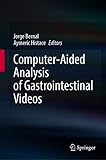Computer-Aided Analysis of Gastrointestinal Videos [electronic resource] /
Material type: TextPublisher: Cham : Springer International Publishing : Imprint: Springer, 2021Edition: 1st ed. 2021Description: XXIV, 187 p. 72 illus., 59 illus. in color. online resourceContent type:
TextPublisher: Cham : Springer International Publishing : Imprint: Springer, 2021Edition: 1st ed. 2021Description: XXIV, 187 p. 72 illus., 59 illus. in color. online resourceContent type: - text
- computer
- online resource
- 9783030643409
- 006.37 23
- TA1634
1. Clinical context for Intelligent Systems in Colonoscopy -- 2. Clinical context for Wireless Capsule Endoscopy Image Analysis -- 3. Technical Context for Intelligent Systems in Colonoscopy -- 4. Technical Context for Wireless Capsule Endoscopy image analysis -- 5. Combination of Color-based Segmentation, Markov Random Fields and Multilayer Perceptron -- 6. Hand Crafted Method: ROI Selection and Texture Description.
This book opens with an introduction to the main purpose and tasks of the GIANA challenge, as well as a summary and an analysis of the results and performance obtained by the 20 participating teams. The early and accurate diagnosis of gastrointestinal diseases is critical for increasing the chances of patient survival, and efficient screening is vital for locating precursor lesions. Video colonoscopy and wireless capsule endoscopy (WCE) are the gold-standard tools for colon and intestinal tract screening, respectively. Yet these tools still present some drawbacks, such as lesion miss rate, lack of in vivo diagnosis capabilities, and perforation risk. To mitigate these, computer-aided detection/diagnosis systems can play a key role in assisting clinicians in the different stages of the exploration. This book presents the latest, state-of-the-art approaches in this field, and also tackles the clinical considerations required to efficiently deploy these systems in the exploration room. The coverage draws upon results from the Gastrointestinal Image Analysis (GIANA) Challenge, part of the EndoVis satellite events of the conferences MICCAI 2017 and 2018. Each method proposed to address the different subtasks of the challenges is detailed in a separate chapter, offering a deep insight into this topic of interest for public health. This book appeals to researchers, practitioners, and lecturers spanning both the computer vision and gastroenterology communities. Dr. Jorge Bernal del Nozal is Associate Professor in the Department of Computer Science at the Autonomous University of Barcelona, and Associate Researcher in the Computer Vision Center, Barcelona, Spain. Dr. Aymeric Histace is Full Professor of Computer Vision in the ETIS (Information Processing and System Team) lab at ENSEA Cergy-Pontoise, France. .


There are no comments on this title.